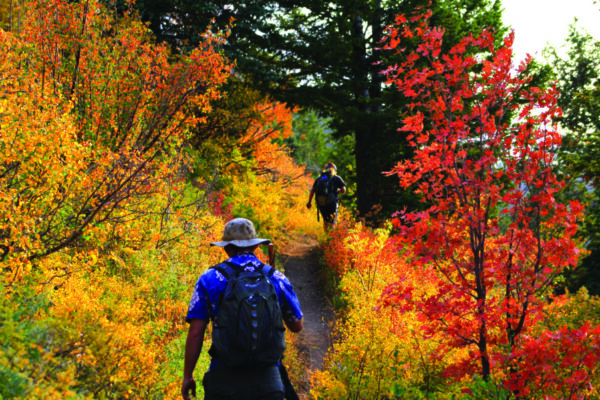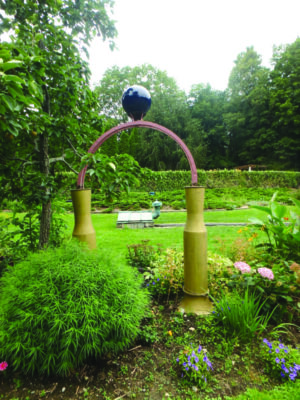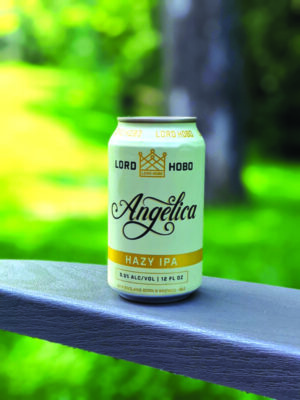Heading into fall is the perfect time to go for a hike, with less heat and humidity, fewer bugs, and views that turn even more picturesque as the leaves start to change. All of this, along with the physical and mental health benefits, is a recipe for hiking happy. Find out how to do it safely, plus check out four southern New Hampshire hikes that prove you don’t have to hit the White Mountains to get in a challenging — but doable — climb.
Hiking well
Hit the trails for a healthy body and mind
by Angie Sykeny
[email protected]
From building muscle strength to lowering stress levels, hiking can have all kinds of benefits for your physical and mental wellness.
“Whether it’s daily, every other day or even just once a week, it’s really worth it for your health to go hiking regularly and spend some time out in nature,” said Lucie Villeneuve, outdoor guide and owner of outdoor guide service Outdoor ESCAPES New Hampshire.
Traversing a mixed terrain of rocks and boulders, tree roots, hills, streams and other natural landscape elements requires a variety of movements, Villeneuve said, giving you a unique full-body workout that you can’t get on an exercise machine or uniform walking surface.
“You’re using pretty much all of your muscles,” she said. “With every step, you’re twisting your ankles in different directions, and you’re putting the brakes on and off with your legs when you’re going uphill and downhill.”
For the same reason, hiking can lead to better balance, stability and coordination, particularly if you’re hiking a mountain where you may need to do some climbing.
“When you’re going up from one piece of rock to the next on your hands and feet, you’re essentially using your whole body, which really improves your balance,” said Conor Benoit, New Hampshire outdoor guide and owner of CMB Guide Service.
Hiking can also be a great workout for cardio and weight loss, depending on your pace and how rigorous the trail is. You could burn as much as 3,000 calories in a day of hiking, Villeneuve said, not only from the physical exertion but also from your body’s work to regulate your body temperature.
“If it’s hot or cold out, your body is going to burn more calories,” she said.
If you wear a backpack to carry some extra water, snacks and emergency supplies — which you should — that will also enhance your workout, Benoit said.
“A few pounds on your back may not sound like much, but by the time you [finish the hike] you’re definitely going to feel it,” he said.
Unlike working out on an exercise machine that you can turn off at any point, “you can’t just quit halfway” during a hike, Benoit said, which can help you push yourself to new physical limits. Setting a goal with a tangible reward, like reaching an interesting landmark or a place with beautiful scenery, can also motivate you to keep going.
“I’ve seen people consistently impressed with how far they are able to make it,” Benoit said. “When you make that commitment to yourself and have the mindset of ‘I’m so close; just a little farther,’ you see that you can accomplish more than you originally thought was possible.”
Hiking is good not just for the body but also for the mind, Villeneuve said. To get the most out of your hike, she recommends making a conscious effort to “be in the present moment,” push away thoughts about what you’ve got going on back home, and home in on your natural surroundings.
“You need to practice having awareness,” she said. “Use all of your senses to take it in: smell the fresh air; feel the temperature of the air; see the views that are right in front of you.”
Conversely, you could use hiking as an opportunity to “reflect [on] and process” things that have been on your mind, away from technology and other distractions, Benoit said, so that you can return to your home and work life with renewed energy and focus.
“That physical and mental exhaustion really sets you up to be more clear-headed throughout the week,” he said. “You leave [the hike] with less than what you carried in, feeling mentally lighter.”
Fall in line
Hiking safely as summer winds down
By Matt Ingersoll
[email protected]

Crisp weather and colorful foliage are great reasons to hit the hiking trails this fall — as long as you’re prepared for a change in the seasons that will bring shorter days and cooler temperatures.
“Fall is my favorite season to hike in behind winter. You don’t have to worry quite as much about sweating and losing all of your moisture,” said Jake King of Thrive Outdoors, a team-building and leadership assessment organization based in Manchester. “At the same time, fall nights get much cooler. … So if you’re stuck, any perspiration or moisture you have is now going to be used against you, whereas in the summer it really does help you cool off.”
One of the most important things to keep in mind when hiking in the fall is that the later in the season, the quicker it will get dark out. With however many hours of daylight you have, King said a good rule of thumb is to give yourself a third of it to get in and two thirds to get out.
“Always give yourself that extra time on the way out,” he said. “A lot of people will like to split it 50/50, thinking they’re going to get out just as quickly as they went in, but then if something goes south, you have no time to play with. … Remember that it’s going to get darker sooner, and then as soon as it does it’s going to get cooler.”
Rick Silverberg, chairman and leadership training coordinator of the Appalachian Mountain Club’s New Hampshire chapter, said the differences in elevation also play a role, as you’re more likely to encounter exposed areas above the trees.
“As soon as you get into those higher elevations, the temperatures get colder … [and] you have a lot more wind,” he said. “In the fall it’s much more dramatic.”
You don’t always have to start your hike dressed in layers. In fact, King said it’s much easier to control your body temperature level by layering up rather than down.
“You should always have a base layer … that sits up against the skin but isn’t too tight, and then a mid-layer and top layer that is wind- and water-resistant,” he said. “Don’t start with all of them on, though. Even if it’s a bit chilly, don’t start warm, because you may find that you’re overheating and once you start sweating, it’s too late. … You’ve broken that seal, so to speak.”
Early on in the fall, you won’t typically encounter a lot of frost. But as the season gets deeper into October and November, morning frost on certain surfaces has the potential to be hazardous.
“A frosty rock can be slippery,” King said. “The other thing to remember is if it starts to warm up during the day, then frost is going to turn into moisture, which is what you want to avoid.”
It’s good to remain mindful too of when specific trails or parks close for the season, which can be any time from mid-September to November depending on where you go.
If you’re heading out for views of the foliage, Silverberg said peak times of the year will differ in the state — far northern areas will usually see their peak a few weeks earlier than those in the south. It will also get colder at night much faster after all the leaves fall from the trees.
Tough but doable
A few challenging, family-friendly hikes
By Meghan Siegler
[email protected]
If you’re not ready to tackle the state’s 4,000-footers but want to take a real hike — as opposed to a walk on a rail trail that you could do wearing flip-flops — here are a few peaks in southern New Hampshire.

Mount Monadnock, Jaffrey
There are a few ways to get to the top of Mount Monadnock, which stands at 3,165 feet — and none of them is a walk in the park. According to nhstateparks.com, “all routes to the top are steep and rocky.” There are three main access points. Monadnock HQ (169 Poole Road), which provides access to the main trails and is the most direct route to the top, and Old Toll Road (9 Halfway House Road), which provides access to many side trails and alternative destinations, are both 4-mile hikes that take approximately four hours to complete. Gilson Pond (585 Dublin Road) is a longer, less populated trail for hikers who are looking for solitude; it’s 6 miles and takes about six hours.
What it’s really like: “I was probably 12 or 13 years old the first time I climbed Mt. Monadnock, but I’ve seen kids and adults young and old successfully scale it. It’s a perfect moderately challenging day hike that will take you no more than a few hours each way up and down. What’s great about it is that, unlike having just one route to the top and one back down to the bottom, there are multiple inter-connecting trails of varying difficulty that you can take, all of which are very clearly marked and easy to follow. The shortest and simplest ones are probably either the White Dot Trail or the White Cross Trail. The White Dot has a very gradual level of steepness that starts to get a bit rockier near the top, but once you reach past the treelines, the views on a clear day are breathtaking. Personally, I like to go up via the White Dot and down via the White Cross, because the latter trail is a little bit steeper and will make for a quicker descent.” — Matt Ingersoll
If you go: Reservations are strongly recommended in order to secure a parking spot at any of the three trailheads. Visitors who do not make a reservation will be admitted on a first come, first served basis. Reservations can be made prior to arrival and no later than 3 p.m. that day at nhstateparks.org. The parking pass costs $15 and includes admission for six people in one vehicle.
Mount Kearsarge, Wilmot & Warner
To get to the summit of Mount Kearsarge, which stands at 2,937 feet and features a fire tower and bald face that offers 360-degree views, there are a few options. From Winslow State Park in Wilmot, there are two trails: the 1.1-mile Winslow Trail and the 1.7-mile Barlow Trail. The former is the more challenging option, while the latter is a more gradual climb and offers vistas of the Andover area, Ragged Mountain and Mount Cardigan. The trailhead has a good-sized picnic area and a playground for kids. The Rollins Trail begins at the picnic area in Rollins State Park in Warner and follows the route of the old carriage road for a half mile to the summit. You could also start at the Lincoln Trail at Kearsarge Valley Road, a 5-mile trail that climbs to the Rollins picnic area.
What it’s really like: “I’ve climbed Kearsarge several times with people of varying levels of fitness. I like that you can go up one main trail and down another so you’re getting different views throughout the hike, and saving your knees from the steeper Winslow Trail if you tackle that first and come down the gentler Barlow Trail. My teenagers both enjoyed this hike, though my daughter kept leaving my son and me in the dust, both on the way up and the way down, and we weren’t exactly taking our time. It definitely feels like a workout on the way up, and I’ve stopped for a few quick breathers no matter who I’ve hiked with. The view at the top is nice, though not quite as spectacular as Mount Major’s, in my opinion.” — Meghan Siegler
If you go: Reservations are strongly recommended and can be made online at nhstateparks.org. Parking is limited, but walk-in spaces are available on a first come, first served basis. Admission is $4 for adults, $2 for children 6 to 11, and free for kids 5 and under and New Hampshire residents who are 65 and older.
Mount Major, Alton
The 1.5-mile Mt. Major Trail begins at a parking area on Route 11 in Alton. The trail ascends a steep, severely eroded section and has some steep scrambles near the top. At 1.3 miles there are two alternate routes, one that forks to the right and climbs up steep ledges (potentially dangerous when wet or icy), and a detour that diverges left. The Brook Trail is 1.7 miles and begins at the junction of Mt. Major Trail and Belknap Range Trail. Aptly named, this trail features two brook crossings in higher water where “some very creative rock hopping is required to keep your feet dry,” according to belknaprangetrails.org. From there on the grade alternates between easy and moderate. The Boulder Loop Trail starts at the trailhead parking area on Route 11 and offers a somewhat gentler climb, with portions of it being part of a snowmobile trail. It features large boulders that you pass by and sometimes go through. At the summit, you’ll find the remnants of the George Phippen hut built in 1925.
What it’s really like: “First, the views at the top are amazing, looking out onto Lake Winnipesaukee, so it’s a well-worth-it reward for a hike that’s particularly tough at the end. I’ve done this one a few times, and my kids have been there more than once for summer camp field trips. There are moments during the climb where I wondered how kids managed to make it to the top; it’s certainly not easy. But it’s also a pretty popular hike — during the summer the parking lot is almost always overflowing, with cars parked along the main road, so if you’re not a fan of crowds, try to save this one for a weekday.” — Meghan Siegler
If you go: There’s no fee to climb Mount Major or to park; just be prepared to walk quite a ways from your car to the trailhead on a nice summer day when cars spill out onto the road.
Mount Sunapee, Newbury
The summit of Mount Sunapee, with an elevation of 2,743 feet, can be reached via ski trails or a number of hiking trails, including Summit, Lake Solitude and Newbury. According to mountsunapee.com, you can also hike any of the ski trails during the summer. Summit is a 2-mile trail at the lodge at Mount Sunapee. The Lake Solitude trail starts east of the summit, and it’s about a mile to White Ledges, which overlooks Lake Solitude. From there, Lake Solitude is a 0.6-mile hike from the overlook. The 2-mile Newbury Trail continues from Solitude Trail and does not return to the ski area base. The trailhead is near the southern end of Lake Sunapee off Route 103 in the village of Newbury, approximately 3 miles from Mount Sunapee Resort.
What it’s really like: “I just hiked Mount Sunapee for the first time a few weeks ago, and I’m not sure what took me so long to get there. Summit Trail is beautiful, although after all the rain we’d had earlier this summer, there were quite a few muddy spots. There were also some steep-ish ascents that had my quads burning, but those were nicely balanced with less intense stretches of trail. When we crested the summit, the view was a little underwhelming, and the ski lodge seemed out of place (I don’t ski and apparently had no idea what happens at the top of a ski mountain). However, a little exploration led to a gorgeous view of Lake Sunapee and the quaint little towns around it. I do wish we’d had enough time to check out Lake Solitude, but it gives me a good reason to go back soon.” — Meghan Siegler
If you go: There are no parking or hiking fees here, and parking at the resort is plentiful for an easy in, easy out day hike.
Treks and Trails
Jake King of Thrive Outdoors in Manchester shares some of his favorite hikes to take during peak fall foliage season.
• Manchester Cedar Swamp Preserve (Country Side Blvd., near Waterford Way, Manchester)
• Massabesic Audubon Center Trails (26 Audubon Way, Auburn): “For people who haven’t really gotten out into the wilderness a lot, it’s a good starter experience. It’s flat and easy.”
• Nottingcook Forest (Woodhill Hooksett Road and South Bow Road, Bow)
• Uncanoonuc Mountains (Mountain Road, Goffstown): “On Uncanoonuc North, you can see bits and pieces of Manchester surrounded by trees, and in the fall, it’s a beautiful sight.”
• Welch-Dickey Mountain Trail (Orris Road, Thornton)
Featured photo: Mt. Major in May 2017. Photo courtesy of Matt Ingersoll.



























